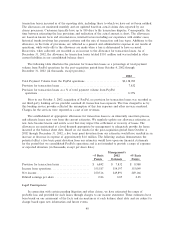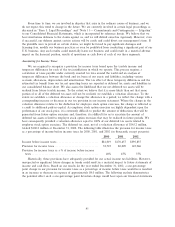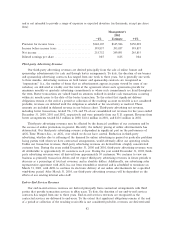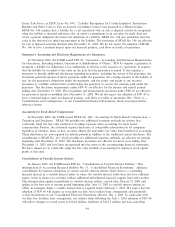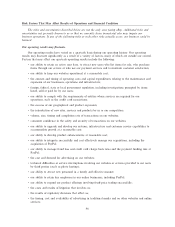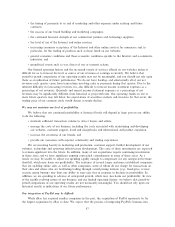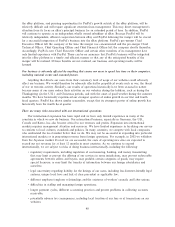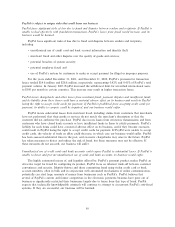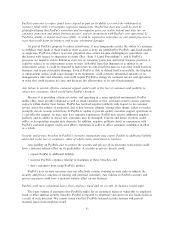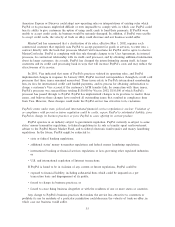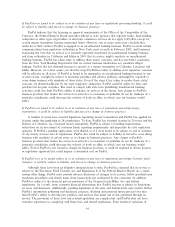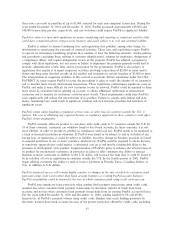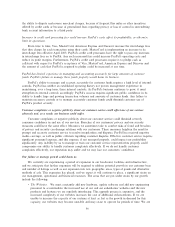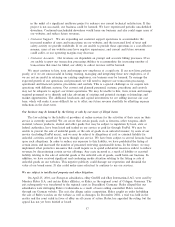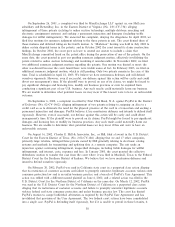eBay 2002 Annual Report Download - page 52
Download and view the complete annual report
Please find page 52 of the 2002 eBay annual report below. You can navigate through the pages in the report by either clicking on the pages listed below, or by using the keyword search tool below to find specific information within the annual report.PayPal is subject to unique risks that could harm our business.
PayPal faces signiÑcant risks of loss due to fraud and disputes between senders and recipients. If PayPal is
unable to deal eÅectively with fraudulent transactions, PayPal's losses from fraud would increase, and its
business would be harmed.
PayPal faces signiÑcant risks of loss due to fraud and disputes between senders and recipients,
including:
‚ unauthorized use of credit card and bank account information and identity theft;
‚ merchant fraud and other disputes over the quality of goods and services;
‚ potential breaches of system security;
‚ potential employee fraud; and
‚ use of PayPal's system by customers to make or accept payment for illegal or improper purposes.
For the years ended December 31, 2001, and December 31, 2002, PayPal's provision for transaction
losses totaled $14.8 million and $28.8 million, respectively, representing 0.42% and 0.41% of PayPal's total
payment volume. In January 2003 PayPal increased the withdrawal limit for unveriÑed international users
to $500 per month in certain countries. This increase may result in higher transaction losses.
PayPal incurs chargebacks and other losses from merchant fraud, payment disputes and insuÇcient funds,
and its liability from these items could have a material adverse eÅect on its business and result in PayPal
losing the right to accept credit cards for payment. If PayPal is prohibited from accepting credit cards for
payment, its ability to compete could be impaired, and our business would suÅer.
PayPal incurs substantial losses from merchant fraud, including claims from customers that merchants
have not performed, that their goods or services do not match the merchant's description or that the
customer did not authorize the purchase. PayPal also incurs losses from erroneous transmissions and from
customers who have closed bank accounts or have insuÇcient funds in them to satisfy payments. PayPal's
liability for such items could have a material adverse eÅect on its business, and if they become excessive,
could result in PayPal losing the right to accept credit cards for payment. If PayPal were unable to accept
credit cards, the velocity of trade on eBay could decrease, in which case our business would suÅer. PayPal
has been assessed substantial Ñnes in the past, and excessive chargebacks may arise in the future. PayPal
has taken measures to detect and reduce the risk of fraud, but these measures may not be eÅective. If
these measures do not succeed, our business will suÅer.
Unauthorized use of credit cards and bank accounts could expose PayPal to substantial losses. If PayPal is
unable to detect and prevent unauthorized use of cards and bank accounts, its business would suÅer.
The highly automated nature of, and liquidity oÅered by, PayPal's payment product makes PayPal an
attractive target for fraud. In conÑguring its product, PayPal faces an inherent trade-oÅ between customer
convenience and security. Identity thieves and those committing fraud using stolen credit card or bank
account numbers, often in bulk and in conjunction with automated mechanisms of online communication,
potentially can steal large amounts of money from businesses such as PayPal's. PayPal believes that
several of PayPal's current and former competitors in the electronic payments business have gone out of
business or signiÑcantly restricted their businesses largely due to losses from this type of fraud. PayPal
expects that technically knowledgeable criminals will continue to attempt to circumvent PayPal's anti-fraud
systems. If they are successful, our business will be harmed.
50


